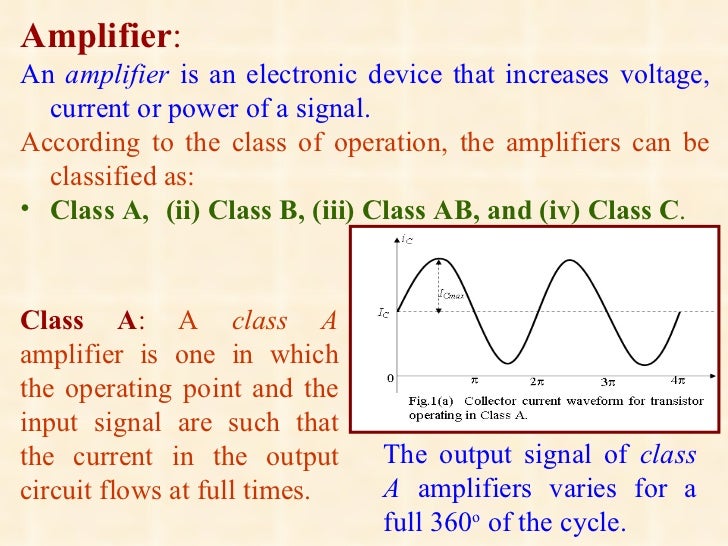
What is meant by power amplifier? The main purpose of this amplifier is to raise the power level of the input signal, to get the large power at the output. A power amplifier is an electronic amplifier designed to increase the magnitude of power of a given input signal. A PA is categorized on the basis of its power rating, which is measured in watts (W). The power rating can be stated in terms of load impedance (ohm) across which the output power is measured.
The boost in power is achieved by significantly increasing the input signal’s voltage. The classes are related to the time period that the active amplifier device is passing current, expressed as a fraction of the period of a signal waveform applied to the input. Power amplifier classes are, in electronics, letter symbols applied to different power amplifier types. Power output is measured in watts or kilowatts.
Efficiency is the ratio of signal power output to total power input (wattage demanded of the power supply or battery ). This value is always less than 1. It is typically expressed as a percentage. Generally, large signal or power amplifiers are used in the output stages of audio amplifier systems to drive a loudspeaker load. A typical loudspeaker has an impedance of between 4Ω and 8Ω, thus a power amplifier must be able to supply the high peak currents required to drive the low impedance speaker. The main function of the power amplifier, which are also known as a “large signal amplifier” is to deliver power, which is the product of voltage and current to the load.

Basically a power amplifier is also a voltage amplifier the difference being that the load resistance connected to the output is relatively low,. If we consider audio amplification, it has several stages of amplification, depending upon our requirement. In practice, any amplifier consists of few stages of amplification. In order to get large power at the output, it is necessary that the input-signal voltage is large.
That is why, in an electronic system, a voltage amplifier always precedes the power amplifier , also, that is why power amplifiers are called large-signal amplifiers. To handle a large amount of voltage and current at the loa a power amplifier is used to deliver a larger amount of power to the load. Dynamic range is the power range over which an amplifier provides useful linear operation, with the lower limit dependent on the noise figure and the upper level a function of the dB compression point.
Define High Power Amplifier. High Power Amplifier synonyms, High Power Amplifier pronunciation, High Power Amplifier translation, English dictionary definition of High Power Amplifier. One that amplifies, enlarges, or extends.
An electronic device that is used to increase the magnitude of an electrical signal. As relatively little energy is wasted as heat, much less heat sinking is required. A typical power amplifier is designed using a multi-stage structure to obtain the required gain and output power , as shown in Figure 1. Therefore, the proposed two-way inverted asymmetrical Doherty power amplifier can be a promising solution for LTE application.
The subjunctive was formerly used in English for situations that were improbable or that expressed a wish. It is only rarely used in modern British English. It is, however, found in certain set phras. Hence the complete signal present at the input is amplified at the output.
The pre-amplifier takes the original signal and boosts it to the minimum input level that the main amplifier can handle. Class A Power Amplifiers. The main amplifier then boosts the signal enough to power loudspeakers. To make this even more complicate the preamp is a combination of activity at the back of the amp and then at the front with this circuitry having to work around the power amplifier section. With a power amplifier , the internals can be laid out in the best way possible for one task alone, taking a single input and amplifying it for your speakers.
It is characteristic of an amplifier that the controlled power Pof the power supply is considerably greater than the controlling, or input, power Pof the signal source (Figure 1). The output power Pis the part of Pthat is supplied to the external circuit, or load. The only disadvantage I can think.
When a power amplifier (PA) is presented with a multi-tone signal at its input, it will amplify the desired signal as well as generate unwanted intermodulation (IM) terms (Figure 1a).
No comments:
Post a Comment
Note: only a member of this blog may post a comment.